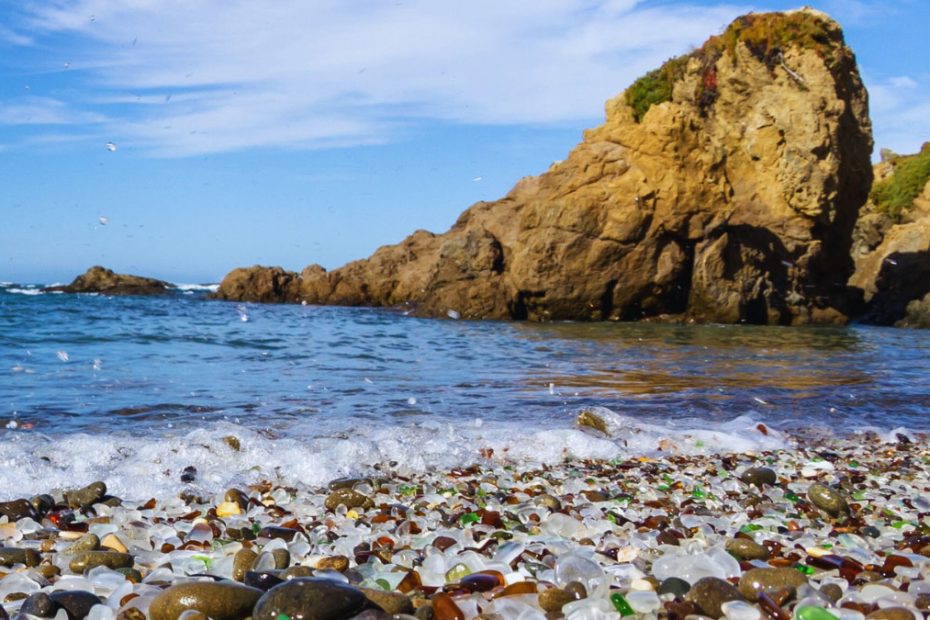Imagine strolling along a sun-kissed beach, the sound of waves gently lapping at the shore, and discovering vibrant pieces of sea glass glinting in the sand. Florida, with its extensive coastline, offers some of the best spots for sea glass hunting. These tiny, colorful treasures, smoothed by years of tumbling in the ocean, are a collector’s dream.
Whether you’re a seasoned beachcomber or a curious newcomer, Florida’s beaches promise an exciting adventure. From the Gulf Coast to the Atlantic shores, you’ll find an array of locations perfect for uncovering these ocean gems. Ready to begin on your sea glass quest? Let’s explore the best sea glass beaches in the Sunshine State.
Key Takeaways
- Florida’s extensive coastline offers prime locations for sea glass hunting, with popular beaches including Siesta Key, Navarre Beach, and Venice Beach.
- Sea glass forms from discarded glass smoothed by ocean waves over many years, with common colors being green, brown, and clear, and rarer colors including blue, red, and true purple.
- Optimal times for finding sea glass are early mornings and after storms, especially around high tide, using tools like mesh bags, sturdy shoes, and small rakes for better results.
- Legal and ethical considerations are important—ensure you understand local laws and practice responsible collecting, such as participating in beach cleanups.
- Collected sea glass can be creatively transformed into jewelry, home décor, mosaic art, garden enhancements, window hangings, gifts, and educational displays.

What Is Sea Glass?
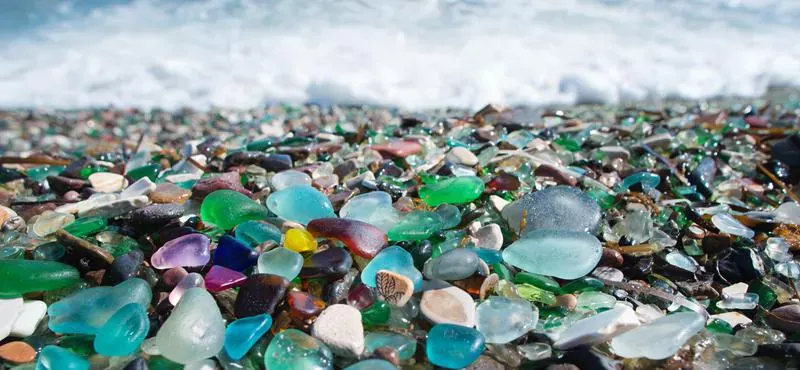
Sea glass forms when discarded glass, such as from bottles or windows, gets smoothed and frosted by the continuous action of ocean waves and tides over many years. Discarded glass becomes smoothed, its edges rounded, and often develops a frosted appearance due to the abrasive action of sand and pebbles. This transformation results in the unique and colorful pieces that wash ashore.
Sea glass comes in many colors. The most common colors are brown, clear, and green. Less common colors include blue, red, orange, yellow, black, and true purple. The rarity of certain colors makes some pieces highly sought after by collectors.
You can find sea glass on beaches with historical human activity. Such locations include old ports, shipwrecks, or areas with a history of coastal settlements. These beaches offer the best opportunities for discovering these intriguing and beautiful pieces of ocean-crafted art.
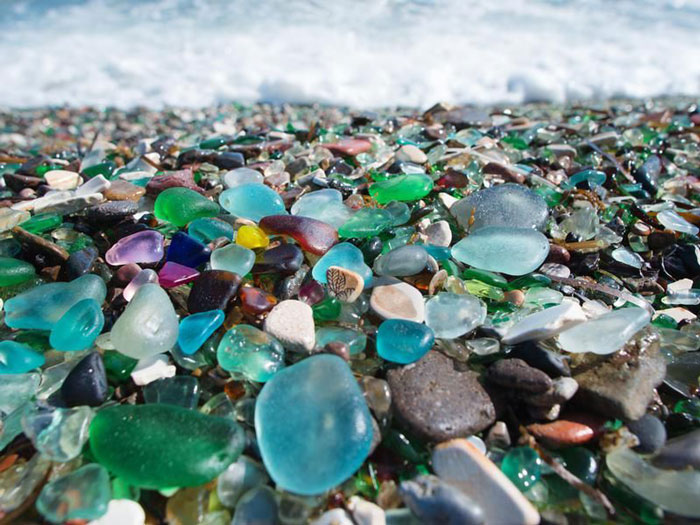
Top Beaches in Florida for Finding Sea Glass
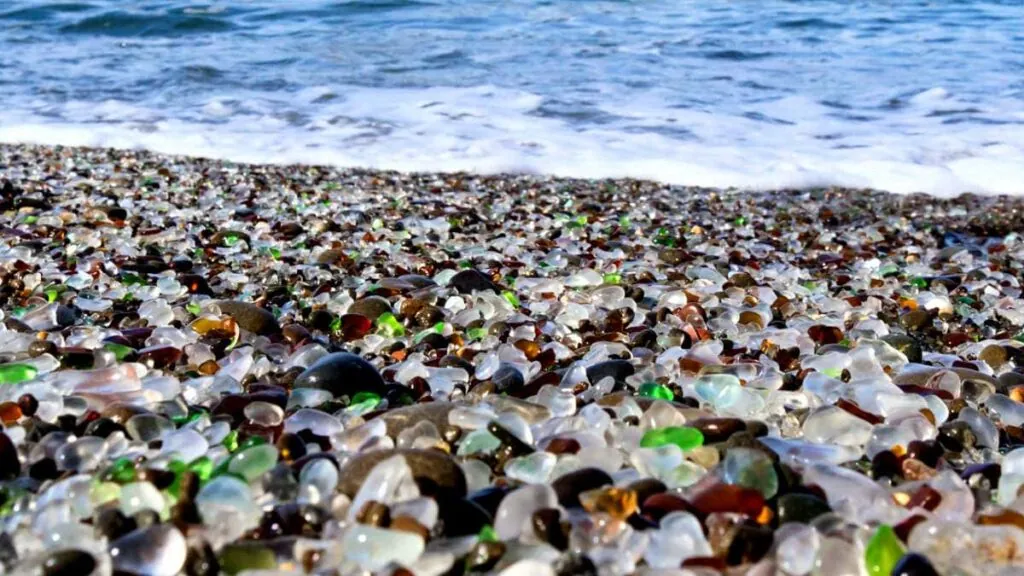
Siesta Key
Siesta Key, located on Florida’s Gulf Coast, features pristine white sand and tranquil blue waters. You’ll find weathered pieces of sea glass, especially after high tide. The gentle Gulf currents play a crucial role in bringing these treasures ashore.
Navarre Beach
Situated on Santa Rosa Island, Navarre Beach boasts emerald green waters and immaculate sands. Sea glass hunters often find success after storms or strong tides. The combination of natural beauty and potential sea glass discoveries makes this beach a favorite.
Venice Beach
Known as ‘The Shark’s Tooth Capital of the World,’ Venice Beach is also rich in sea glass. The ocean currents here frequently wash ashore a variety of sea glass pieces. For optimal chances, plan your visit after a storm or during low tide.
Coral Cove Park, Jupiter Island
Coral Cove Park on Jupiter Island is a hidden gem with rocky shorelines and clear turquoise waters. The park’s unique world contributes to a significant amount of sea glass washed ashore. This lesser-known spot provides a quieter search experience.
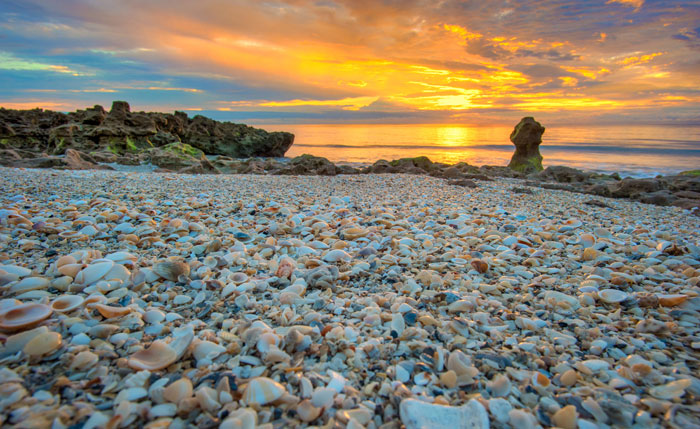
Fort Myers Beach
Fort Myers Beach offers expansive sandy shores and a vibrant local scene. The beach is a great place for finding sea glass, particularly along the tide lines and after storms. Its wide span makes it ideal for long, leisurely searches.
Jacksonville Beach
Jacksonville Beach is a bustling area with a diverse coastline. Sea glass often ends up on the shore due to ocean currents and storm activity. Along with sea glass, you can explore the lively pier and local dining spots.
Bowman’s Beach
Located on Sanibel Island, Bowman’s Beach is famous for its abundant shelling opportunities and sea glass finds. A visit here after high tide or a storm increases your chances of discovering unique sea glass pieces.
Daytona Beach
Daytona Beach, famous for its hard-packed sand, hosts numerous events and activities. But, it’s also a good spot for sea glass hunting. The best times are early mornings or after significant weather events.
Clearwater Beach
Clearwater Beach combines white sandy shores with vibrant nightlife and amenities. The beach’s currents often deliver sea glass treasures, especially along the less crowded northern parts.
Jensen Beach
Jensen Beach stands out for its beautiful shorelines and accessible location. Post-storm and early morning visits enhance the likelihood of finding sea glass. The calm waters and pleasant ambiance make it perfect for a relaxed search.
Hutchinson Island
Hutchinson Island features stretches of unspoiled beaches, ideal for sea glass hunting. After storms, new pieces often wash ashore, waiting to be discovered. The island’s serene environment adds to the charm of your treasure hunt.
Tips for Finding Sea Glass
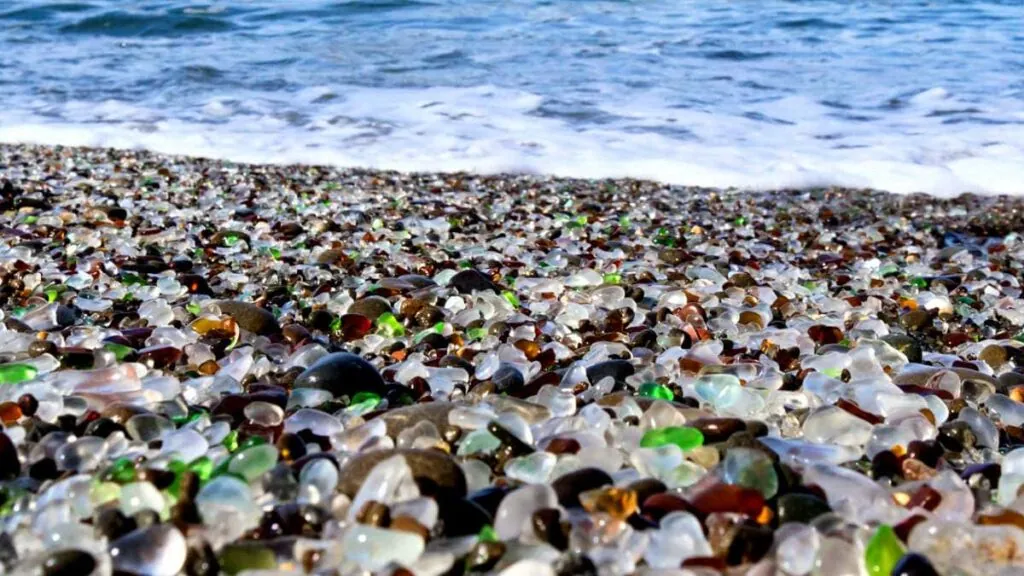
Best Time and Tides
Finding sea glass is most rewarding when you maximize the conditions. Head out early in the morning, shortly after high tide. Morning light illuminates sea glass, making it easier to spot. High tides bring new pieces ashore, so time your visit around these cycles.
Storms and strong currents also increase your chances. After a storm, the ocean churns up and deposits new treasures, perfect for keen collectors. Check local tide charts and weather forecasts to plan your visit. Venus Beach and Navarre Beach, known for post-storm finds, are excellent spots to explore during these times.
Tools and Techniques
Bringing the right tools enhances your sea glass hunt. A small mesh bag or bucket helps collect and carry your finds without losing them. Wear sturdy shoes for exploring rocky areas like Coral Cove Park. Gloves keep your hands safe while sifting through debris.
Use a small rake or scoop to search through sand and pebbles, especially in tidal pools where sea glass often accumulates. Be patient and methodical, scanning the shoreline and focusing on areas with abundant shell fragments, as sea glass tends to mix with them.
- Siesta Key: White sand and gentle waves, great after high tide.
- Navarre Beach: Pristine beaches and green waters, ideal post-storm.
- Venice Beach: Known for shark teeth, also rich in sea glass after storms.
- Coral Cove Park: Rocky shorelines, clear waters, a quieter spot for sea glass.
By knowing the best times, tides, and using helpful tools, your sea glass hunting adventures on Florida’s beautiful shores will be fruitful and enjoyable.
Sea Glass Colors and Rarity
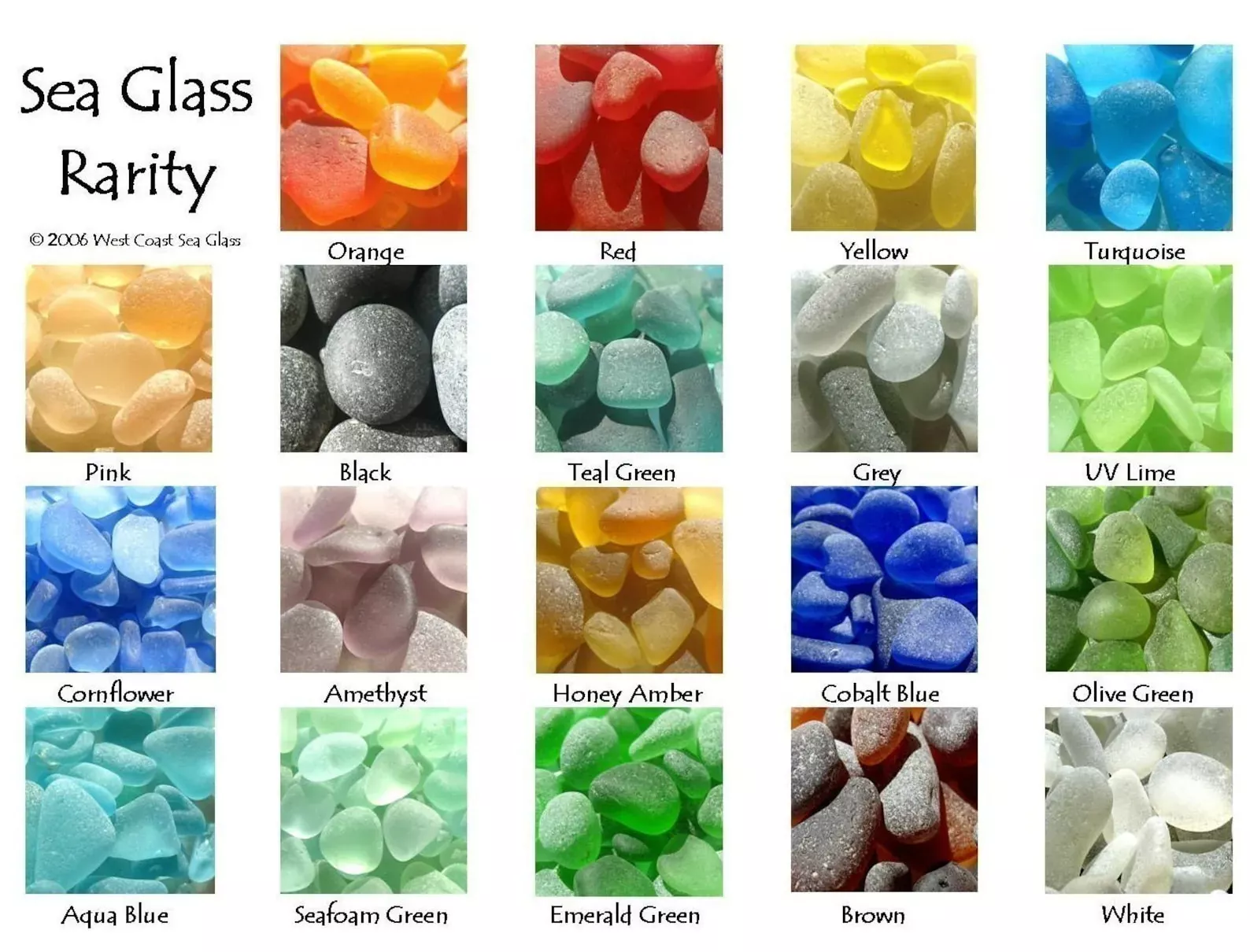
Beachcombing along Florida’s shores offers a kaleidoscope of sea glass colors. Understanding the hues you’ll encounter helps enhance the thrill of your discovery.
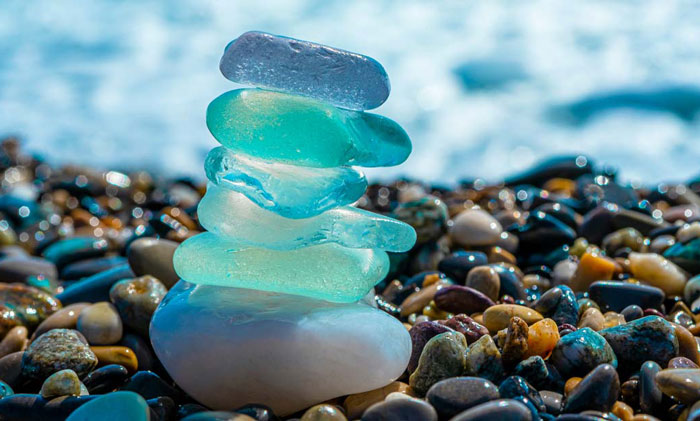
Common Colors
Most pieces you’ll find are green, brown, or clear.
- Green: Comes from beverage bottles, often in vivid emerald or olive shades.
- Brown: Sources include beer and medicine bottles, resulting in amber or dark brown pieces.
- Clear: Originates from various containers and windows, showing up as frosted white.
Rare Colors
Rare colors add excitement to your search.
- Blue: Often stems from art glass, old bottles, or medicine containers.
- Red: Seldom found, but sourced from signal lights or decorative glass.
- True Purple: Indicates old glass with manganese, which turns purple when exposed to sunlight over time.
Collectors eagerly seek out blue, red, and true purple sea glass. Coral Cove Park on Jupiter Island is especially known for offering these rare finds.
Legality and Ethics of Collecting Sea Glass
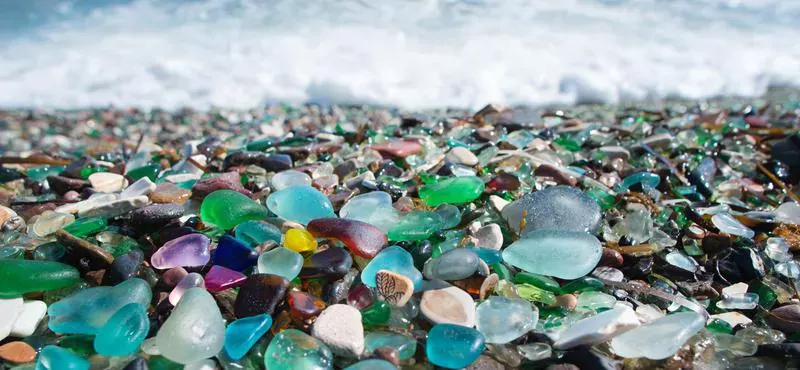
Although exploring Florida’s beaches for sea glass can be a rewarding hobby, understanding the legal and ethical considerations is crucial for responsible collecting.
Legal Considerations
Before collecting sea glass, familiarize yourself with local laws prohibiting the removal of natural items from certain protected areas. For instance, many state parks and marine sanctuaries have strict regulations to preserve their ecosystems. Always check posted signs or consult local authorities for the rules specific to the beach you’re visiting. Ignorance of these laws can lead to fines or other penalties.
Responsible Collecting Practices
Practicing ethical sea glass collecting ensures the experience remains enjoyable for everyone. Only collect small amounts, leaving ample glass for other collectors and to maintain the beach’s natural beauty. Avoid breaking or damaging any marine life habitats; for example, refrain from overturning rocks or disturbing seaweed unnecessarily. If possible, participate in or organize beach cleanups to offset the impact of your collecting activities by removing trash and other debris.
By adhering to legal guidelines, respecting wildlife, and leaving the environment better than you found it, you can enjoy sea glass collecting while ensuring the sustainability of Florida’s beautiful beaches.
What to Do with Collected Sea Glass

Sea glass, with its vibrant colors and weathered appearance, provides endless creative possibilities. You can transform your finds into various decorative and functional items, blending your beachcombing adventures seamlessly with artistic projects.
Jewelry Making
Create unique pieces of jewelry, such as necklaces, earrings, and bracelets, by wrapping sea glass in wire or setting it in custom-designed bezels. Various online tutorials can guide you through the process with minimal tools required.
Home Décor
Incorporate sea glass into home décor items. Fill clear vases, jars, or bowls with assorted pieces for colorful, natural home accents. Glue smaller shards onto picture frames, mirrors, or coasters for a personalized touch.
Mosaic Art
Construct stunning mosaics using sea glass. Arrange pieces into intricate patterns on tabletops, garden stones, or wall art. Consider integrating other beach finds like shells and driftwood to enhance the design.
Garden Enhancements
Enhance your garden with sea glass. Use pieces as mulch in plant pots or garden beds. Create garden ornaments by embedding sea glass in cement stepping stones or edging around plant borders.
Window Hangings
Craft window hangings by threading sea glass onto fishing line or wire. Hang these creations in sunny windows where the light catches the glass, casting colorful reflections throughout the room.
Gifts
Use sea glass to make heartfelt, handmade gifts. Create custom jewelry, home décor items, or personalized artwork. Such gifts carry added value due to the thought and effort involved.
Educational Displays
Develop educational displays for classrooms or nature centers. Highlight the environmental impact of glass in the ocean and the beauty of recycling through sea glass. These displays can inspire others to engage in sustainable practices.
Each sea glass piece tells a story of its journey through the ocean. By transforming your sea glass into various items, you not only preserve these natural treasures but also create lasting memories and beautiful keepsakes.
Conclusion
Embarking on a sea glass hunting adventure along Florida’s stunning coastline offers a unique blend of excitement and tranquility. Whether you’re a seasoned collector or a curious beginner, the Sunshine State’s diverse beaches provide the perfect setting to uncover these ocean gems.
As you explore the best sea glass beaches in Florida, remember to respect the environment and adhere to local regulations. Enjoy the thrill of discovering rare and colorful pieces while creating lasting memories. Happy hunting!
Frequently Asked Questions
What is sea glass?
Sea glass is glass that’s been discarded into the ocean, shaped and smoothed over many years by waves, resulting in colorful and frosted pieces.
Where are the best beaches in Florida to find sea glass?
Some of the best beaches in Florida for sea glass hunting include Siesta Key, Navarre Beach, Venice Beach, Coral Cove Park, and Fort Myers Beach.
What are the best conditions for finding sea glass?
The best times to find sea glass are early morning after high tide and during or after storms. These conditions often bring new glass pieces to the shore.
What colors of sea glass are most common in Florida?
The most common colors of sea glass found in Florida are brown, clear, and green. Rare colors like blue, red, and true purple are especially prized.
Is it legal to collect sea glass in Florida?
On state park beaches, it is illegal to collect sea glass. It’s important to check local laws and regulations regarding the removal of natural items from these areas.
What tools should I bring for sea glass hunting?
It’s recommended to bring a small bag or bucket for collecting, gloves to protect your hands, and sturdy shoes for navigating rocky areas.
How can I use the sea glass I collect?
Sea glass can be used to make jewelry, home décor, mosaics, garden enhancements, window hangings, heartfelt gifts, and educational displays.
Why are some sea glass colors rare?
Rarer colors like blue, red, and true purple were less commonly used in consumer products, thus fewer pieces end up in the ocean, making them prized finds.
What should I do if I find sea glass in a state park?
If you find sea glass in a state park, enjoy its beauty but leave it where you found it, as collecting is prohibited in these protected areas.
Can I take sea glass home with me from a Florida beach?
Yes, on non-state park beaches, you can generally take sea glass home, but always verify local regulations to ensure you are collecting responsibly.

